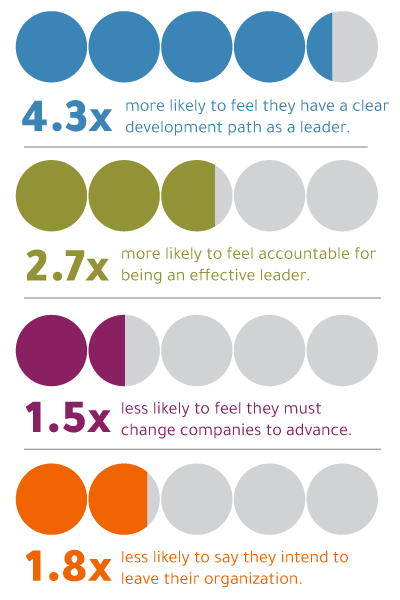Imagine your favorite sports team. Whether it’s football, basketball, or soccer, the success of the team largely hinges on one key role: the coach. The coach not only strategizes, but also connects, motivates, and develops players’ skills. In the corporate world, coaching is just as vital. Creating a coaching culture within an organization can be the difference between a team that merely functions and one that excels.

This is more important than ever given that nearly 40% of leaders say they don’t get adequate coaching from their manager, according to our latest Global Leadership Forecast research. This gap underscores the urgent need to develop robust coaching skills, across companies. Our research also shows that coaching is the most identified skill area leaders want to improve. In fact, a staggering 85% of HR professionals surveyed believe it will be critical for leaders to develop coaching skills within the next three years.
These insights clearly signal that investing in a coaching culture is not just a luxury—it’s a necessity. By making coaching a priority, companies can empower their leaders, boost team performance, and achieve lasting success.
But what does it take to build an effective coaching culture? In this blog, I’ll discuss the benefits of creating a coaching culture, the steps to build one, potential hurdles, and the critical role leaders play.
What Is a Coaching Culture?
In workplaces with a coaching culture, coaching is a fundamental part of every workday. Coaching is woven into daily interactions, fostering continuous learning, development, and growth.
At its core, a coaching culture signifies a shift from traditional hierarchical structures to a more empowering and cooperative approach. It involves open communication, active listening, and thoughtful questioning to unleash the potential of individuals and teams.

One of the biggest false assumptions is that coaching is top-down, in which a senior, more experienced employee supports an employee below them. In a healthy, effective coaching culture, all team members, regardless of their level or role, help each other to be their best selves by creating a safe space for everyone to learn, practice new skills, and grow.
While the coaching relationship between leader and direct report is critical, employees also need coaching from their peers. And leaders need coaching from their direct reports.
The key is that everyone needs feedback to grow. They also need to be open to learning. After all, leaders aren’t experts in everything. They need coaching and feedback from others, regardless of where they sit in the org chart.
For a coaching culture to work, leaders need the competence and confidence to coach, motivate, and develop others. They must learn how to have better conversations that consider both the practical and personal needs of the person being coached.
What Are the Benefits of Creating a Coaching Culture?

Creating a coaching culture isn’t just about making employees happier—it can transform your entire organization from the ground up. Our Global Leadership Forecast found that the benefits are substantial and far-reaching, impacting individual employees and the company as a whole.
Consider the profound effects coaching has on individuals. Leaders who get quality coaching from their managers are:
- 4.3X more likely to feel they have a clear development path as a leader.
- 2.7X more likely to feel accountable for being an effective leader.
- 1.5X less likely to feel they must change companies to advance.
- 1.8X less likely to say they intend to leave their organization.
This translates to a more stable, engaged, and growth-oriented cohort of leaders.

But the benefits of a strong coaching culture extend far beyond individual growth. Organizations that prioritize coaching see remarkable company-wide results. Companies with a strong coaching culture are:
- 1.5X more likely to be among the top 10% of financial performers.
- 1.6X more likely to be recognized as a best place to work.
- 2.9X more likely to be capable of engaging and retaining top talent.
Additionally, companies that use coaching by direct managers and external mentors have a stronger leadership bench. They promote more leaders internally and maintain a pipeline of high-potential talent–crucial advantages in a tight labor market.
Conversely, the absence of effective coaching can have significant negative consequences. High-potential employees are twice as likely to depart if their manager isn’t an effective coach. Only 11% of high potentials plan to leave within the next year when they receive quality coaching from their managers, compared to 20% when they don’t.
In short, fostering a coaching culture isn’t just beneficial—it's becoming imperative for organizational success. From boosting individual growth to elevating company performance, the advantages are too significant to overlook.
The Steps to Creating a Coaching Culture
So how can you realize the benefits of creating a coaching culture? Here are five key steps:

1. Get senior-level support.
To be successful, culture change initiatives often need to start at the top. Senior leaders need to allocate time to coach in meetings, one-on-ones, and informal conversations. But most importantly, a senior leader must be seen to “walk the walk.”
Three key factors can help leaders increase their coaching effectiveness:
- Managers and/or formal mentors set a positive example with coaching.
- Leaders use objective assessments to get feedback on their coaching skills and guide development.
- Leaders see the impact of coaching on their overall effectiveness.
When senior leaders champion coaching, not just in words but in action, it sets a powerful example for the entire organization.

2. Give all leaders coaching skills.
The second step is to give leaders at every level coaching skills. In addition, make sure that people in informal leadership roles (such as project managers and agile leaders) have the skills to coach. What’s the best way to do this? At a minimum, train every formal and informal leader in the core leadership skills.
The core skills are a combination of emotional intelligence and coaching that will enable people to prepare for an assignment or to learn and improve for the future. Ideally, leaders can also access additional resources that support their development.
As such, many companies have built robust learning journeys to train their leaders to become capable coaches. The result? You take a big step towards creating a coaching culture that gets you the benefits mentioned earlier.

3. Encourage employees to apply coaching skills on the job.
The next step, after training, is to apply the skills on the job. The adage is simple but true: practice makes perfect. But how can leaders get the coaching practice they need to be successful?
First, leaders need an action plan. While it is common to have development activities for a group of learners, it is important that every leader has a personalized follow-up plan that connects behavior with the organization’s business priorities. Some companies offer small group follow-up sessions for leaders to discuss coaching opportunities and share experiences and lessons learned.
Others leverage peer coaching, online coaching simulations, or apps that can provide feedback in a minute or two. Above all, it’s critical to create an environment and action plan that enables and encourages everyone to practice, apply learnings, and get feedback on their progress.
Consider how athletes and artists hone their talents. They practice regularly (daily!) and for extended periods of time. They ask for and expect feedback from others. A similar level of commitment and dedication is required to become a good coach. And when that commitment is combined with opportunities to coach, you’re well on your way toward creating a coaching culture.

4. Create accountability.
Everyone needs to be held accountable for their role in creating a successful coaching culture. Oftentimes, leaders alone are held responsible for coaching and teaching their teams how to coach each other. But in a true coaching culture, everyone is responsible for coaching and everyone is being coached, regardless of their level.
An outcome of effective coaching is that leaders are developing teams of people who feel supported and empowered to make decisions. The resulting accountability system encourages employees to take ownership of their performance and encourages managers to take ownership of how they coach others.
How will you know if your organization has this level of accountability? When every employee at every level is having coaching conversations on a regular basis.

5. Measure for effectiveness and ROI.
Finally, it is important to evaluate the effectiveness and ROI of your company’s coaching efforts. Who is coaching successfully? How often are coaching conversations occurring? What business outcomes are improving as a result? Tapping into this information will help you understand what elements of a coaching culture are working well and what areas need improvement.
The first step in measuring ROI is to identify metrics that your coaching culture should influence. Common metrics include employee engagement and retention, productivity, and customer satisfaction.
Then, collect quantitative and qualitative data over time on the metrics you’ve identified and analyze it to spot improvements and trends. If you can link coaching to improvements in business results, you’ll showcase the value of a coaching culture. By measuring the ROI of a coaching culture, organizations make data-driven decisions, optimize their coaching programs, and continuously improve employee development and performance. This benefits individual employees and contributes to the overall success and growth of the organization.
The Role of Leaders in Fostering a Coaching Culture
Leaders are key to building and nurturing a thriving coaching culture that boosts employee development and drives organizational success.
By acting as coaching role models, they inspire and motivate their teams, demonstrating a commitment to coaching that others want to adopt. When leaders engage in coaching conversations, they show that coaching is a valued part of growth.
Leaders should also provide resources and support. They can provide training to enhance coaching skills and knowledge and set aside time for practice and feedback.
Weaving coaching into performance discussions is also critical. This practice encourages regular feedback, goal setting, and development planning, making coaching a natural part of the performance management process and embedding a coaching mindset into the organization’s culture.
How to Overcome the Challenges of Creating a Coaching Culture
Changing organizational culture is hard work—it requires behavior change. Corporate culture has countless layers that affix over time. Organizational culture includes rituals, symbols, workspace layout and decor, expressed values, unconscious assumptions, and much more. Basically, everything someone experiences when they interact with the organization are "bits and pieces" of the company’s culture.
So, how can you build an effective coaching culture within the existing culture? Here are five things you can do:
1. Encourage stakeholder support.
Internal communications are an important step to get everyone on the same page about why creating a coaching culture is important. And C-suite support is crucial. Your C-suite should deliver messages across the entire organization about why coaching is valuable and how leaders can do it.
2. Highlight and reward the good.
The goal is to make effective coaching so effortless and normalized that it becomes an unconscious cultural habit. But how can this be done? Leaders must do more than convey the message that coaching is important. They need to be positive examples of good coaches for others to see in action.
Leaders, at all levels, need to truly “walk the walk,” encouraging employees to behave in similar ways that align with the company’s values. Highlighting and rewarding positive coaching examples and outcomes is a great way to get the message across.
3. Clearly explain the benefits.
As the people responsible for creating and maintaining a coaching culture, we must not accept the “I don’t have time for this” type of excuse. We must instill the belief that coaching is one of the most important parts of any leader’s job. How do we do this?
Convincing leaders that coaching is expected from everyone requires a clear explanation of the benefits. And these benefits are different for each business, and possibly even for each team and team leader. But touching on these points is crucial in getting everyone on board.
4. Don’t make coaching an evaluation tool.
Employees aren’t always excited about coaching. Many perceive coaching as a form of negative feedback, for example, “You are not doing something right so let me tell you how to improve.”
The objective of coaching is to achieve better results, it is not meant to be an evaluation tool. Furthermore, building a coaching culture is about being coached, and it requires that all employees become coaches for their peers.
The objections to coaching from individual contributors are the same as those from leaders:
- I don’t have time.
- I don’t have the opportunity.
- I don’t know how.
It is important to show people that they will not need to add to the list of what they are doing at work. Rather, they need to adjust their routines to incorporate coaching.
5. Promote coaching as a mindset.
After everybody understands the concept of creating a coaching culture, they may expect a detailed plan of what they ought to do.
Unfortunately, it’s not that straightforward. Building a coaching culture is about promoting a coaching mindset. It’s also about developing leaders who can handle situations in the moment, rather than holding intervention-like meetings with some coaching so that a box can be checked.
A Healthy Coaching Culture and Organizational Culture
While they may not know it, leaders are telling us they want and need to be part of a coaching culture. The best way to develop and practice coaching skills is to engage in group development in a supportive environment.
If your organization is already investing time and money in workplace coaching, why stop there? Dig deeper and embrace fully creating a coaching culture. Make sure coaching is happening at every level and as often as possible. The result? You will see better productivity, more engagement, higher performance, and a healthier overall organizational culture.
Learn how DDI can help you improve your organizational culture.
Bruce Court partners with organizations on all aspects of their leadership strategy. He’s experienced in every facet of leadership strategy design, development, and execution. Outside of work, Bruce likes to travel with his wife, Maureen. He loves eating at great restaurants as well as sampling good wine and craft beers. Bruce is also a huge fan of smooth jazz.
Topics covered in this blog

